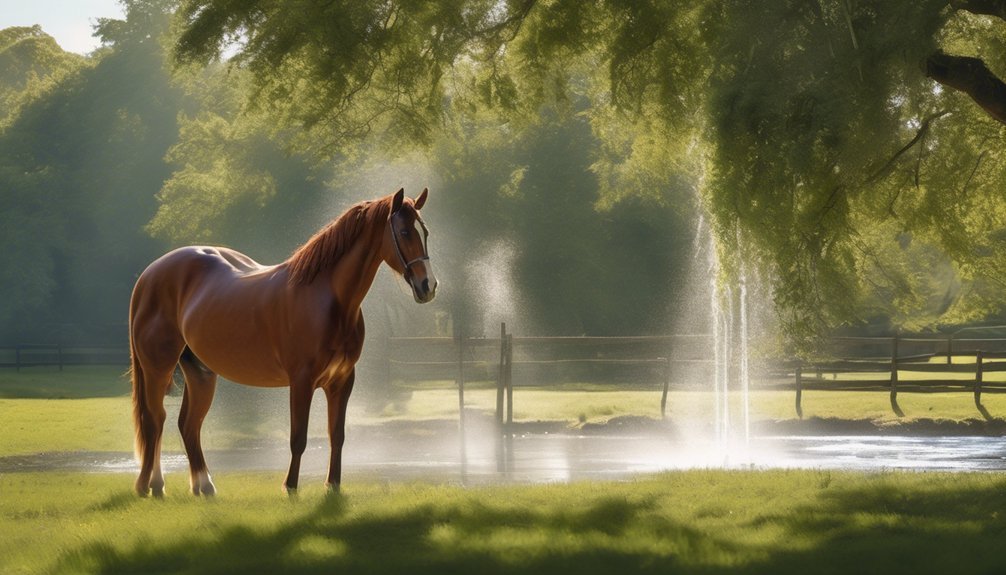
Maintaining your horse's coat during hot weather is crucial for their overall health and comfort. With the right grooming routine, you can help your horse stay cool and prevent skin issues. By understanding their needs and making small adjustments to their care, you'll ensure they thrive in the heat. Let's explore the best practices for coat maintenance and discover how to keep your horse feeling their best all summer long.
Key Takeaways
- Establish a regular grooming routine to remove dirt and loose hair, promoting better air circulation and sweat evaporation.
- Use appropriate grooming tools like a currie brush for dirt removal and a soft brush for sensitive areas to maintain coat health.
- Ensure your horse has constant access to fresh, clean water and consider adding electrolytes to enhance hydration during hot weather.
- Provide shade options such as trees or shelters and apply equine sunscreen to protect vulnerable areas from sun exposure.
- Adjust turnout times to cooler parts of the day, like early mornings or late afternoons, to minimize heat stress on your horse.
Understanding the Importance of Coat Care in Hot Weather
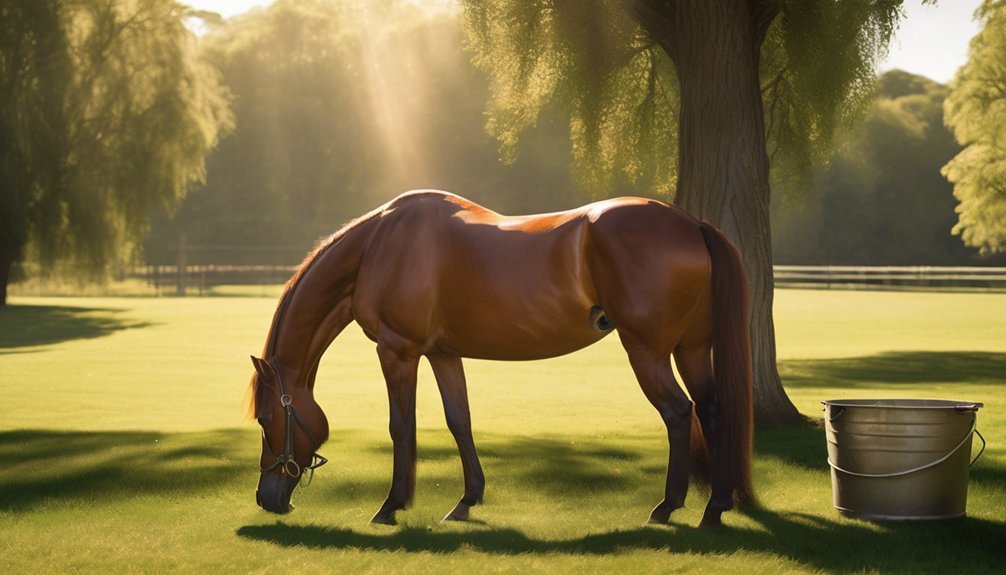
When temperatures rise, understanding the importance of coat care for your horse becomes essential. A healthy coat plays a vital role in sweat regulation, helping your horse cool down effectively.
Neglecting coat health can lead to overheating and discomfort, which can affect your horse's overall well-being. Regularly checking for dirt and debris is crucial, as a clean coat allows for better air circulation and sweat evaporation.
Additionally, consider the type of products you use; natural grooming tools can enhance coat condition and shine. Remember, your horse relies on you to maintain their comfort during hot weather.
Establishing a Regular Grooming Schedule
Establishing a regular grooming schedule is crucial for maintaining your horse's coat and overall health. Aim for a grooming frequency that suits both your horse's needs and your routine, ideally every day or every few days.
Consistent grooming helps remove dirt, debris, and loose hair, promoting healthy skin and a shiny coat. As seasons change, make necessary seasonal adjustments; during hot weather, your horse may sweat more, requiring more frequent grooming to manage the coat's condition.
Pay attention to your horse's unique needs, as some may require extra care. By keeping this schedule, you strengthen your bond, ensuring your horse feels loved and cared for, while also keeping their coat in top shape throughout the warmer months.
Choosing the Right Grooming Tools
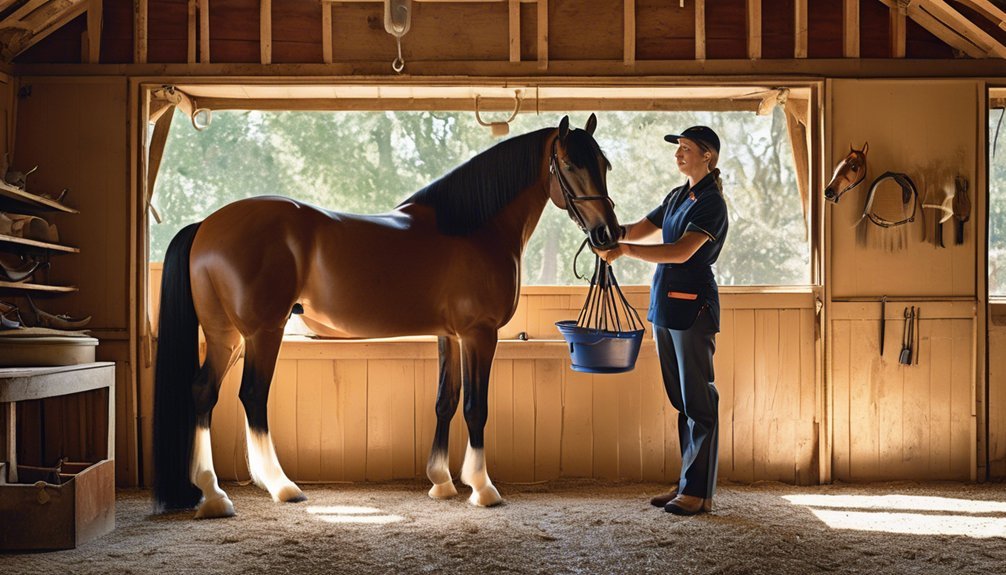
Choosing the right grooming tools can make a significant difference in maintaining your horse's coat. Investing in effective brushes and other grooming tool types not only enhances your horse's appearance but also promotes its well-being.
Here are four essential tools to consider:
- Currie Brush: Great for removing dirt and loose hair.
- Dandy Brush: Perfect for getting rid of stubborn grime and debris.
- Soft Brush: Ideal for sensitive areas, leaving a nice shine.
- Hoof Pick: Essential for keeping hooves clean and healthy.
Using these tools consistently will keep your horse comfortable and looking its best, especially during hot weather.
Keeping Your Horse Hydrated
Hydration is crucial for your horse's overall health and coat condition. Ensuring your horse maintains adequate water intake during hot weather can make a world of difference.
Start by providing fresh, clean water at all times; horses often drink more when water is presented in a clean trough or bucket. Consider adding electrolytes to their feed or water to encourage drinking, especially after exercise.
You can also offer soaked hay or grain as it retains moisture, contributing to hydration. Pay attention to your horse's behavior—if they seem lethargic or refuse to drink, it's time to take action.
Managing Sun Exposure and Skin Protection
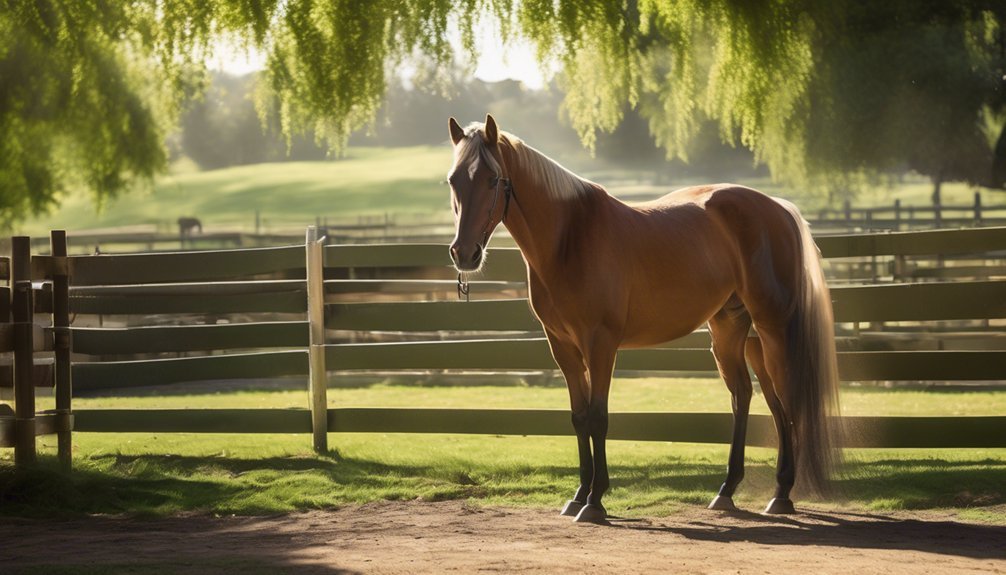
While you may not think of sun exposure as a primary concern for your horse, managing it's essential for their skin health and coat condition.
Protecting your horse from harmful UV rays can make a significant difference in their overall comfort. Here are some effective strategies for sun protection:
- Provide Shade Options: Use trees, shelters, or shade cloths to create cool areas for your horse to retreat to during peak sun hours.
- Apply Sunscreen: Use equine-specific sunscreen on vulnerable areas like the nose and around the eyes.
- Consider UV-Blocking Rugs: Invest in lightweight, UV-blocking horse rugs for additional protection during sunny days.
- Adjust Turnout Times: Plan outdoor activities for early mornings or late afternoons when the sun's intensity is lower.
Your horse will thank you for keeping them safe and comfortable!
Adjusting Feeding for Seasonal Needs
As the seasons change, your horse's nutritional needs can shift significantly, so it's essential to adjust their feeding regimen accordingly.
During hot weather, focus on seasonal nutrition by ensuring your horse has access to plenty of fresh water and consider offering lighter, nutrient-dense feeds. High-quality forage is crucial, as it provides hydration and essential nutrients without excess heat production during digestion.
You might also want to reduce grain intake to prevent unnecessary energy spikes, making dietary adjustments that better suit their activity levels. Keep an eye on their body condition and coat health; these are indicators of how well your adjustments are working.
Recognizing Signs of Heat Stress
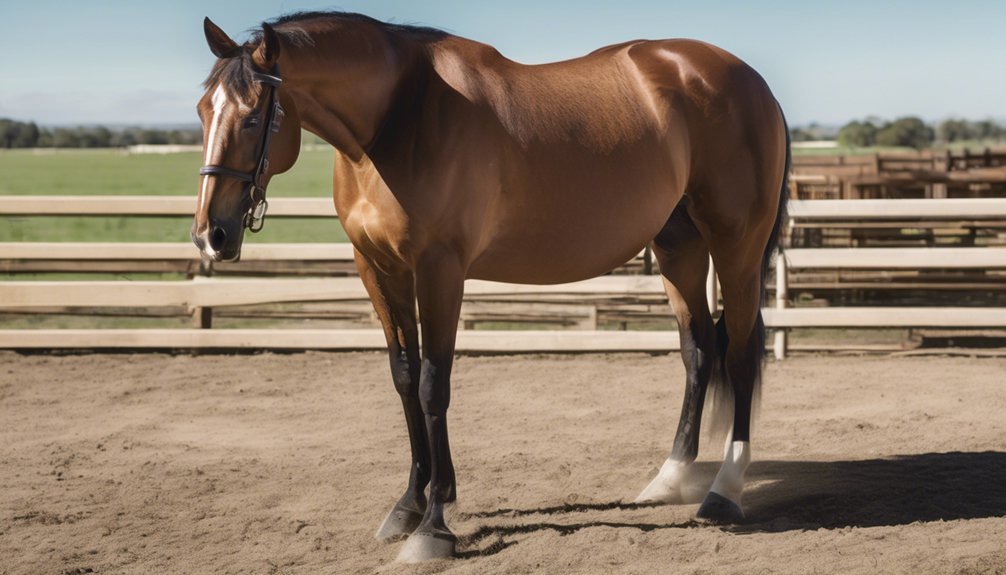
Recognizing the signs of heat stress in your horse is crucial for their well-being, especially during the sweltering summer months.
Heat exhaustion can escalate quickly, so staying vigilant is key. Look for these critical indicators:
- Excessive sweating – If your horse is sweating more than usual, it may be struggling to cool down.
- Increased heart rate – A rapid heartbeat can signal distress and overheating.
- Behavioral changes – If your normally calm horse becomes agitated or lethargic, it's a red flag.
- Labored breathing – Heavy, labored breaths indicate they're having trouble regulating their temperature.
Maintaining a Comfortable Living Environment
Creating a comfortable living environment for your horse is essential to their overall health and well-being. To help your horse thrive during hot weather, focus on effective ventilation techniques.
Ensure your stable has adequate airflow, allowing cool breezes to circulate. You might consider installing fans or using natural shade to enhance stable cooling.
Keep the stable clean and dry, as this will reduce heat and humidity. Regularly check for signs of discomfort, and adjust their environment as needed.
Fresh, cool water should always be available, encouraging hydration. By being proactive and attentive, you can create a soothing space that supports your horse's comfort, helping them maintain a healthy coat and overall happiness during those sweltering days.
Frequently Asked Questions
How Does Humidity Affect My Horse's Coat Care?
Humidity affects your horse's coat maintenance by promoting sweat and skin irritations. You'll need to adjust grooming routines, ensuring proper cleaning and moisturizing to keep their coat healthy and comfortable in humid conditions.
Can a Horse's Coat Color Influence Heat Absorption?
Yes, a horse's coat color can influence heat absorption. Darker coats absorb more heat, making them warmer in the sun. Consider your horse's color when choosing shade or cooling methods during hot days.
Are There Specific Supplements for a Healthier Coat in Summer?
For a healthier coat in summer, consider supplements rich in omega fatty acids and biotin. Prioritize summer nutrition, ensuring your horse's diet supports coat health, making their coat shine while keeping them comfortable and happy.
What Are the Best Bathing Practices During Hot Weather?
During hot weather, you should bathe your horse frequently to cool them down. Use cooling techniques like lukewarm water and gentle sponging to refresh their coat, ensuring they feel comfortable and well-cared for in the heat.
How Often Should I Clip My Horse's Coat in Summer?
You should clip your horse's coat every 4 to 6 weeks during summer grooming. This clipping frequency helps keep your horse comfortable and prevents overheating, ensuring they stay happy and healthy throughout the hot months.
Conclusion
By prioritizing your horse's coat care during hot weather, you're not just grooming; you're nurturing their well-being. Think of it like tending to a garden. Just as flowers thrive with regular watering and sunlight, your horse flourishes with proper grooming, hydration, and shade. Stay vigilant for signs of heat stress, and adjust their care as needed. With your attention and love, your horse will shine brightly, even on the hottest days, reflecting the bond you both share.





